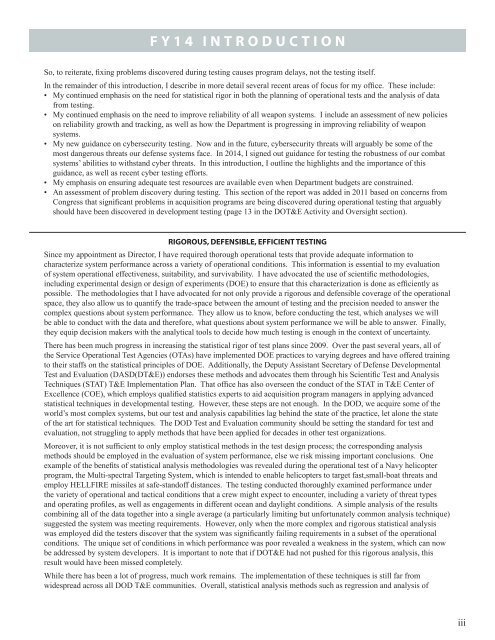2014DOTEAnnualReport
2014DOTEAnnualReport
2014DOTEAnnualReport
You also want an ePaper? Increase the reach of your titles
YUMPU automatically turns print PDFs into web optimized ePapers that Google loves.
FY14 IntroductionSo, to reiterate, fixing problems discovered during testing causes program delays, not the testing itself.In the remainder of this introduction, I describe in more detail several recent areas of focus for my office. These include:• My continued emphasis on the need for statistical rigor in both the planning of operational tests and the analysis of datafrom testing.• My continued emphasis on the need to improve reliability of all weapon systems. I include an assessment of new policieson reliability growth and tracking, as well as how the Department is progressing in improving reliability of weaponsystems.• My new guidance on cybersecurity testing. Now and in the future, cybersecurity threats will arguably be some of themost dangerous threats our defense systems face. In 2014, I signed out guidance for testing the robustness of our combatsystems’ abilities to withstand cyber threats. In this introduction, I outline the highlights and the importance of thisguidance, as well as recent cyber testing efforts.• My emphasis on ensuring adequate test resources are available even when Department budgets are constrained.• An assessment of problem discovery during testing. This section of the report was added in 2011 based on concerns fromCongress that significant problems in acquisition programs are being discovered during operational testing that arguablyshould have been discovered in development testing (page 13 in the DOT&E Activity and Oversight section).Rigorous, Defensible, Efficient TestingSince my appointment as Director, I have required thorough operational tests that provide adequate information tocharacterize system performance across a variety of operational conditions. This information is essential to my evaluationof system operational effectiveness, suitability, and survivability. I have advocated the use of scientific methodologies,including experimental design or design of experiments (DOE) to ensure that this characterization is done as efficiently aspossible. The methodologies that I have advocated for not only provide a rigorous and defensible coverage of the operationalspace, they also allow us to quantify the trade-space between the amount of testing and the precision needed to answer thecomplex questions about system performance. They allow us to know, before conducting the test, which analyses we willbe able to conduct with the data and therefore, what questions about system performance we will be able to answer. Finally,they equip decision makers with the analytical tools to decide how much testing is enough in the context of uncertainty.There has been much progress in increasing the statistical rigor of test plans since 2009. Over the past several years, all ofthe Service Operational Test Agencies (OTAs) have implemented DOE practices to varying degrees and have offered trainingto their staffs on the statistical principles of DOE. Additionally, the Deputy Assistant Secretary of Defense DevelopmentalTest and Evaluation (DASD(DT&E)) endorses these methods and advocates them through his Scientific Test and AnalysisTechniques (STAT) T&E Implementation Plan. That office has also overseen the conduct of the STAT in T&E Center ofExcellence (COE), which employs qualified statistics experts to aid acquisition program managers in applying advancedstatistical techniques in developmental testing. However, these steps are not enough. In the DOD, we acquire some of theworld’s most complex systems, but our test and analysis capabilities lag behind the state of the practice, let alone the stateof the art for statistical techniques. The DOD Test and Evaluation community should be setting the standard for test andevaluation, not struggling to apply methods that have been applied for decades in other test organizations.Moreover, it is not sufficient to only employ statistical methods in the test design process; the corresponding analysismethods should be employed in the evaluation of system performance, else we risk missing important conclusions. Oneexample of the benefits of statistical analysis methodologies was revealed during the operational test of a Navy helicopterprogram, the Multi-spectral Targeting System, which is intended to enable helicopters to target fast,small-boat threats andemploy HELLFIRE missiles at safe-standoff distances. The testing conducted thoroughly examined performance underthe variety of operational and tactical conditions that a crew might expect to encounter, including a variety of threat typesand operating profiles, as well as engagements in different ocean and daylight conditions. A simple analysis of the resultscombining all of the data together into a single average (a particularly limiting but unfortunately common analysis technique)suggested the system was meeting requirements. However, only when the more complex and rigorous statistical analysiswas employed did the testers discover that the system was significantly failing requirements in a subset of the operationalconditions. The unique set of conditions in which performance was poor revealed a weakness in the system, which can nowbe addressed by system developers. It is important to note that if DOT&E had not pushed for this rigorous analysis, thisresult would have been missed completely.While there has been a lot of progress, much work remains. The implementation of these techniques is still far fromwidespread across all DOD T&E communities. Overall, statistical analysis methods such as regression and analysis ofiii







